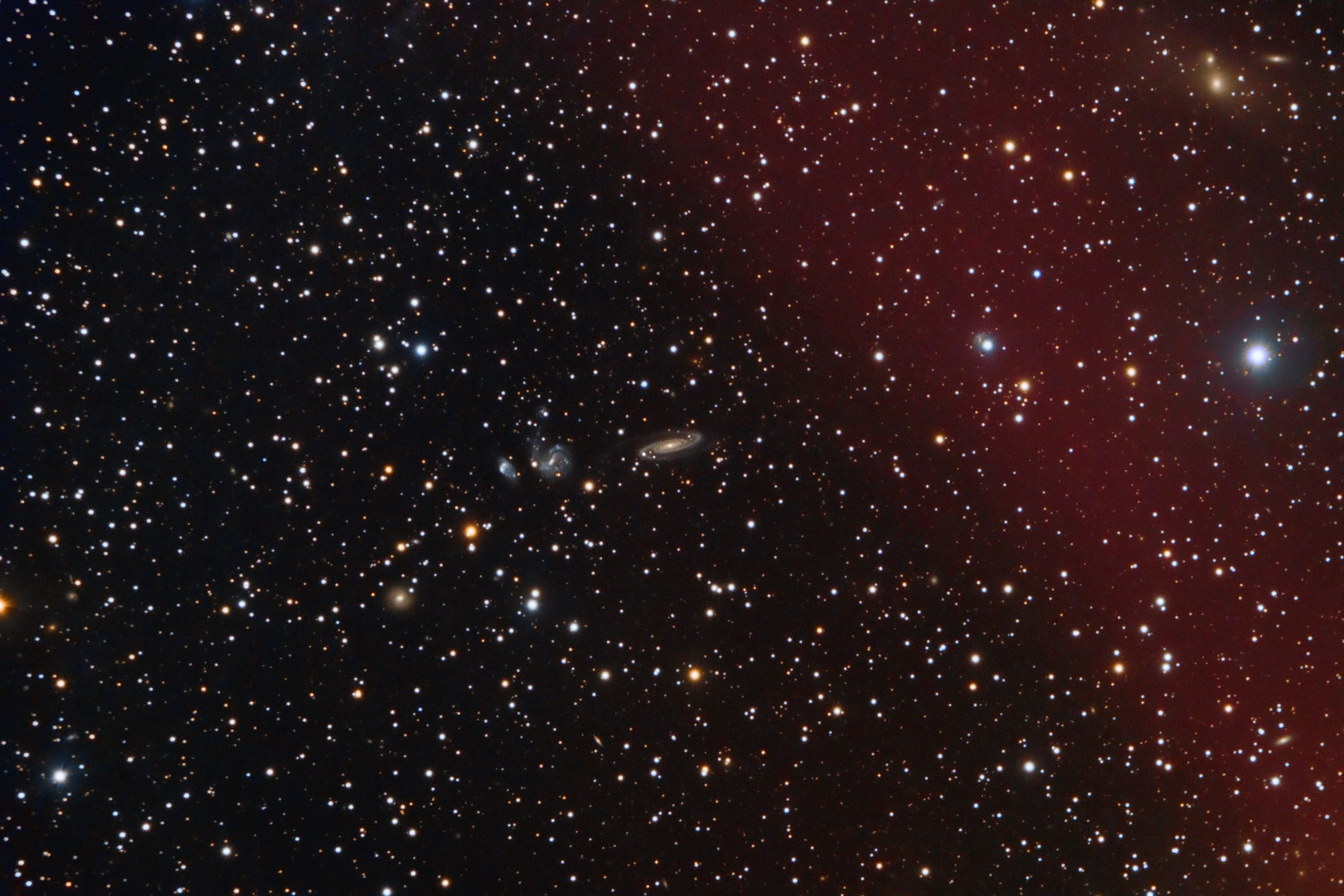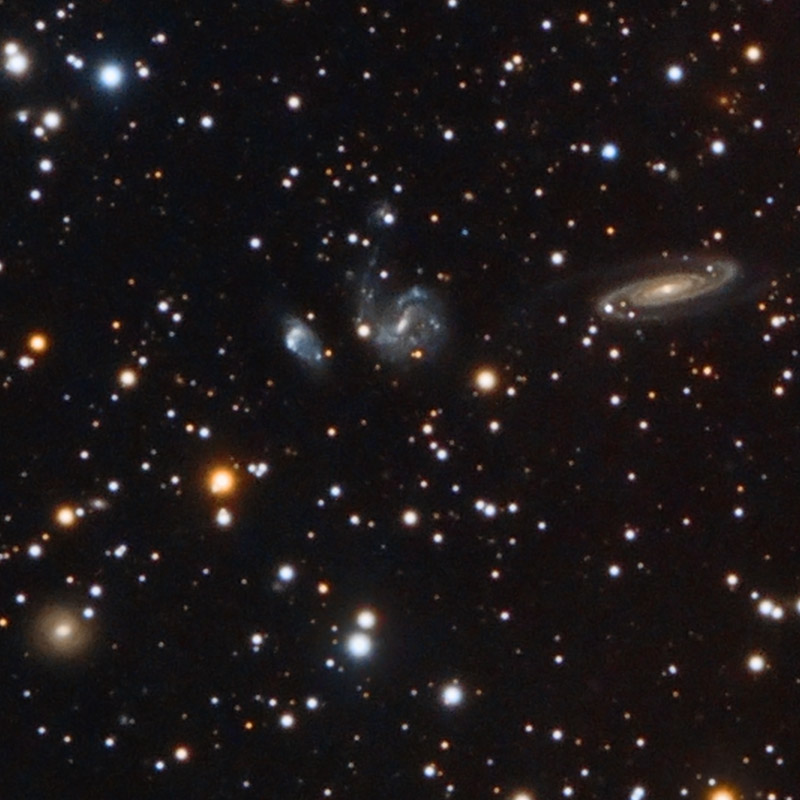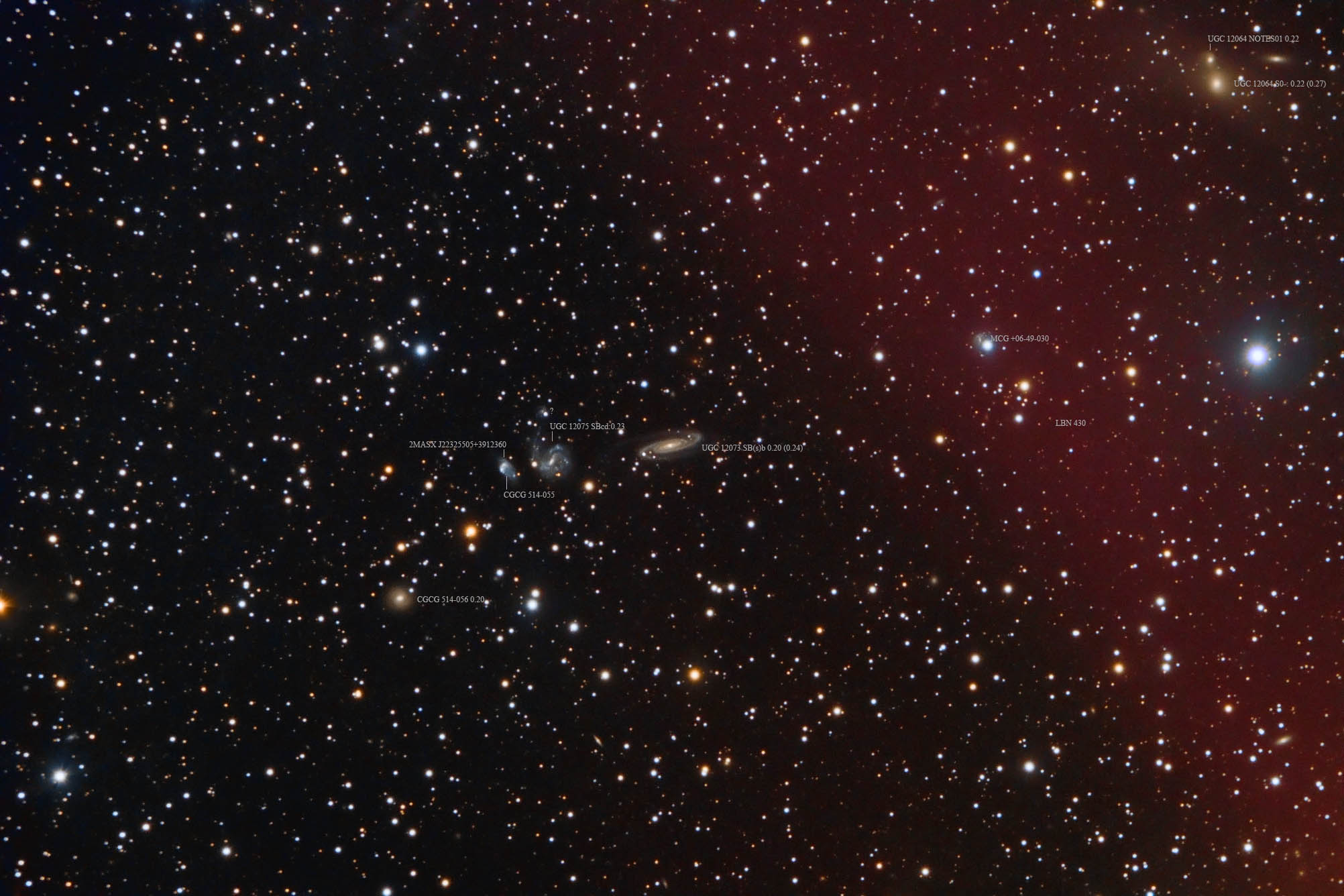Object name: UGC12073Designation(s): UGC12073, UGC12075, UGC12064, The WBL 682 galaxy group consists of 4 galaxies though one appears to be two galaxies sharing a common envelope. It is located in southern Lacerta about 220 million light-years distance. Three (or four depending on how you count the double galaxy) appear to be interacting. The fourth appears to be an innocent bystander.
The WBL 682 galaxy group consists of 4 galaxies though one appears to be two galaxies sharing a common envelope. It is located in southern Lacerta about 220 million light-years distance. Three (or four depending on how you count the double galaxy) appear to be interacting. The fourth appears to be an innocent bystander.
Adding a streak of color to the image LBN 430, the streak through the right side of the image. Beyond it is the UGC 12064 galaxy group also at about 220 million light-years.
UGC 12073 is a large spiral apparently drawn out even further due to interaction with other members of the group. The full extent of its two drawn-out arms reaches about 156,000 light-years making it a huge spiral. The core of this galaxy appears double. I found no mention of this in the literature (what little there was). I don't really see the bar it is said to have. It could be these are knots at either end of a very foreshortened bar that outshines the core.
Near the center of the group is UGC 12075. It appears it could have made Arp's atlas under spirals with a companion on its arm. It appears to have drawn out the arm much like in the case of M51 and its companion. Oddly I couldn't find the companion in NED's database under any designation.
Further east is CGCG 514-055 which appears to refer to both objects in a common halo. While I found a separate designation for the northern core I found none for the lower one other than the above designation centered on the entire halo rather than the dense core. Neither had any distance information. They may be just interacting with each other and not even related to the other three. One note refers to the pair as possibly being a symbiotic pair. I hadn't realized galaxies were living creatures. The bystander is CGCG 514-056. NED doesn't try to classify it. Looks S0/a to my untrained eye.
UGC 12064 is also known as 3C 449 a strong radio source with twin-jets. An HST image shows a 3" wide dust lane around the very core of the galaxy. I wasn't able to find it in my data. Another note says it is rich in globular star clusters but again I didn't pick any up nor does NED catalog any. http://iopscience.iop.org/article/10.1086/317356 Usually the jets are at right angles to the disk of a disk galaxy but not in this case. It might be due in part to the disk being highly warped. You can read a lot more about it at this PDF. http://arxiv.org/pdf/astro-ph/0510650v3.pdf
Being in the zone of avoidance only the major galaxies of the field have been cataloged, even few have much data so the annotated version is rather skimpy on details.
14" LX200R @ f/10, L=4x10' RGB=2x10', STL-11000XM, Paramount MEz
Adding a streak of color to the image LBN 430, the streak through the right side of the image. Beyond it is the UGC 12064 galaxy group also at about 220 million light-years.
UGC 12073 is a large spiral apparently drawn out even further due to interaction with other members of the group. The full extent of its two drawn-out arms reaches about 156,000 light-years making it a huge spiral. The core of this galaxy appears double. I found no mention of this in the literature (what little there was). I don't really see the bar it is said to have. It could be these are knots at either end of a very foreshortened bar that outshines the core.
Near the center of the group is UGC 12075. It appears it could have made Arp's atlas under spirals with a companion on its arm. It appears to have drawn out the arm much like in the case of M51 and its companion. Oddly I couldn't find the companion in NED's database under any designation.
Further east is CGCG 514-055 which appears to refer to both objects in a common halo. While I found a separate designation for the northern core I found none for the lower one other than the above designation centered on the entire halo rather than the dense core. Neither had any distance information. They may be just interacting with each other and not even related to the other three. One note refers to the pair as possibly being a symbiotic pair. I hadn't realized galaxies were living creatures. The bystander is CGCG 514-056. NED doesn't try to classify it. Looks S0/a to my untrained eye.
UGC 12064 is also known as 3C 449 a strong radio source with twin jets. An HST image shows a 3" wide dust lane around the very core of the galaxy. I wasn't able to find it in my data. Another note says it is rich in globular star clusters but again I didn't pick any up nor does NED catalog any. http://iopscience.iop.org/article/10.1086/317356 Usually the jets are at right angles to the disk of a disk galaxy but not in this case. It might be due in part to the disk being highly warped. You can read a lot more about it at this PDF. http://arxiv.org/pdf/astro-ph/0510650v3.pdf
Being in the zone of avoidance only the major galaxies of the field have been cataloged, even few have much data so the annotated version is rather skimpy on details.
14" LX200R @ f/10, L=4x10' RGB=2x10', STL-11000XM, Paramount ME Related Designation(s):2MASS J22312058+3921296, 2MASS J22323340+3912558, 2MASS J22324887+3912381, 2MASX J22312062+3921298, 2MASX J22323337+3912560, 2MASX J22324885+3912380, 2MASXi J2231205+392129, 2MASXi J2232333+391255, 2MASXi J2232488+391238, 2MFGC 16976, 2XMM J223120.5+392130, 2XMMp J223120.5+392130, CGCG 2229.1+3906 NED01, CGCG 2230.3+3858, CGCG 2230.6+3858, CGCG 514-050 NED01, CGCG 514-053, CGCG 514-054, CRATES J2231+3921, CRATES J223120.58+392129.5, CXO J223120.6+392129, HDCE 1194 NED003, LDCE 1527 NED008, LDCE 1527 NED009, LQAC 337+039 001, MAPS-PP O_0778_0081807, MAPS-PP O_0778_0082187, MCG +06-49-029, MCG +06-49-032, MCG +06-49-033, NPM1G +38.0462, PGC 069055, PGC 069101, PGC 069110, SSTSL2 J223120.54+392129.3, UGC 12064, UGC 12073, UGC 12075, UGC12064, UGC12073, UGC12075, USGC U815 NED02, USGC U815 NED03, USGC U815 NED04, UZC J223120.6+392130, UZC J223233.4+391255, UZC J223248.8+391239, WBL 682-001, WBL 682-002, [RC2] A2229+39, | | 

